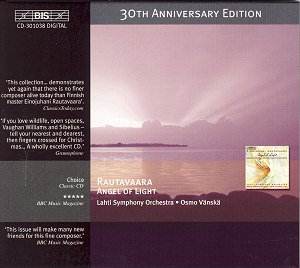A mid-price issue from BIS?? What on earth is
the world coming to?? It is BISís 30th Anniversary
and they have re-released a series of 30 discs all culled from
their extensive catalogue at mid-price. The discs have retained
their original catalogue numbers, only these have been prefixed
by the number 30. This disc was originally issued in December
1999, and may still be available on its original catalogue number.
In fact, the disc carries the original catalogue number, as does
the booklet, so I hope dealers do not get confused when ordering
these products.
I donít know how long it will be available at
this price, but in case it is deleted, donít hesitate. This is
a superb disc, issued in this form when the 7th Symphony
was originally released. BIS filled up the disc with the Cantus
Arcticus and Dances with the Winds which had already
held their place in the catalogue with other couplings.
This combination of orchestra and conductor is
pre-eminent in this repertoire and there are not many who can
do a better job. Judging by the recording dates, this symphony
must have just missed being recorded in the Lahti Symphony Orchestraís
new hall, but this is of little consequence when BISís recording
is of such high quality.
Angel of Light (Symphony No.
7) was completed in 1995 and was commissioned by the Bloomington
Symphony Orchestra. It was awarded the Midem prize at Cannes,
as well as a Grammy nomination and the ABC prize in Australia.
It continues the series of works inspired by Rainer Maria Rilkeís
"Duinoís Elegies". In these, "every angel is terrifying"
so that its "stronger presence would kill if it held you
tight." Concentration on this literary work acted somewhat
as a mantra with the composer, and has given rise to "Angels
and Visitations", "Angel of Dusk", and
the present work "Angel of Light". Because of
this, there is no actual programme, more that the mantra has generated
an atmosphere which has resulted in long lines, epic narrative,
and a sense of symphonic development. This feeling of development
is often distressingly absent from much modern music and I am
sure that this sense of organic growth has been partly responsible
for the composerís current popularity.
The second work on this well filled disc is the
four movement Flute Concerto which unusually is written
for four different members of the flute family: the wooden piccolo,
the alto flute, the gold flute, and the bass flute. These are
not played simultaneously and multi-tracked, but each is chosen
to reflect the character of the passages in which they are played.
A novel idea which works very well. The flautist, Petri Alanko,
plays extremely well, no doubt inspired by the superb accompaniment.
The final work is the Cantus Arcticus
for orchestra and prepared tape of birdsong. The composerís
own tape recording is used in this performance, consisting of
a number of northern birds, such as cranes and swans, together
with other unidentified species. There is here, a wonderful opportunity
for bird-watchers to do a bit of detective work. Cantus Arcticus
is the composerís most famous work, proving once again that
a gimmick markets well. The composer asked listeners to think
of autumn and Tchaikovsky Ė well I am not so sure about that,
but it certainly does not detract from the pleasure I have had
from this disc. Very highly recommended.
John Phillips
